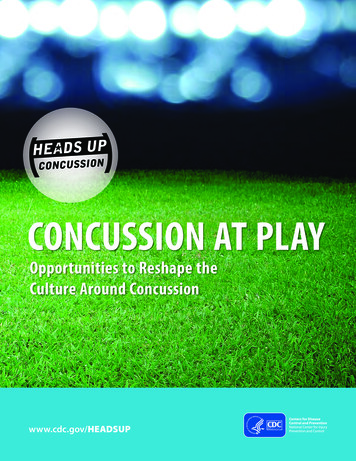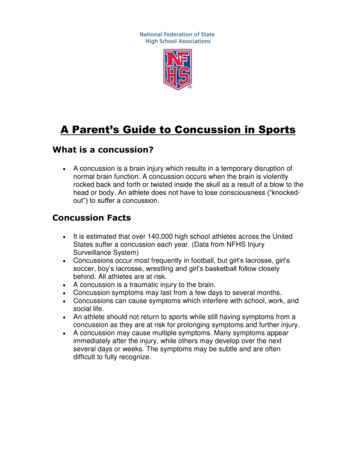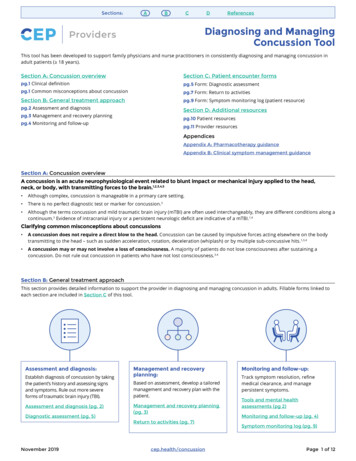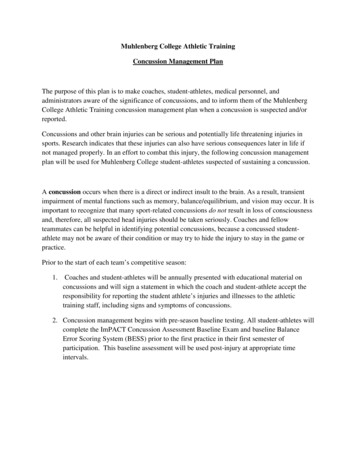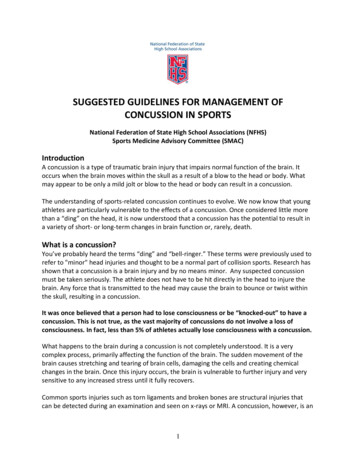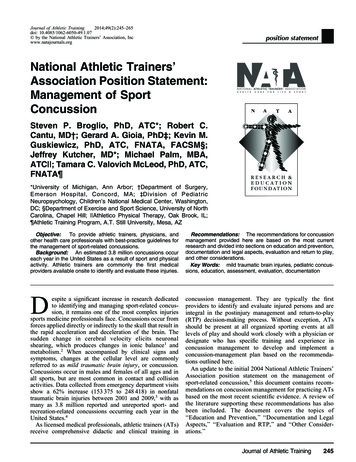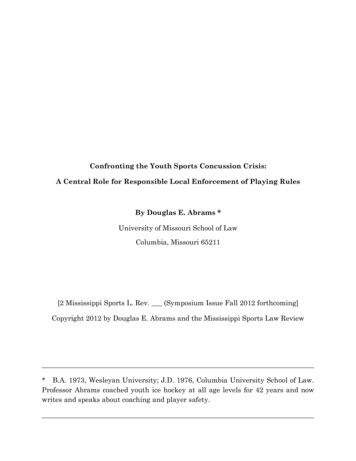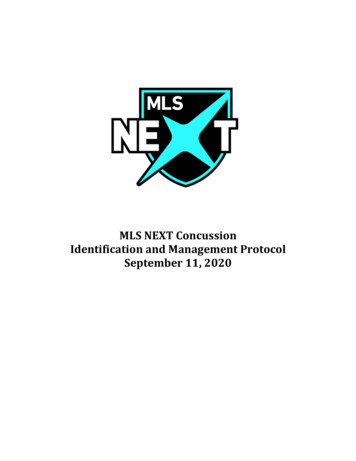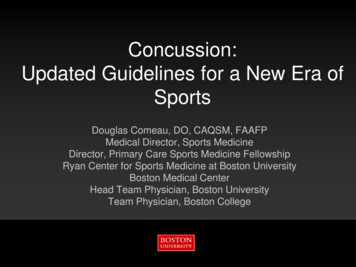
Transcription
Concussion:Updated Guidelines for a New Era ofSportsDouglas Comeau, DO, CAQSM, FAAFPMedical Director, Sports MedicineDirector, Primary Care Sports Medicine FellowshipRyan Center for Sports Medicine at Boston UniversityBoston Medical CenterHead Team Physician, Boston UniversityTeam Physician, Boston College
DisclosuresBoston University Slideshow Title Goes Here I, Douglas Comeau, nor any family members, haveany relevant financial relationships to be discussed,directly or indirectly, referred to or illustrated with orwithout recognition within the presentation
Learning ObjectivesBoston University Slideshow Title Goes Here Identify the warning signs of concussionKnow appropriate return to play progressionAttempts at preventionFuture research
Concussion can happen at any momentBoston University Slideshow Title Goes Here
With the Game on the LineBoston University Slideshow Title Goes Here
And it can be on the roadBoston University Slideshow Title Goes Here
Would you be ready as Team Physician?Boston University Slideshow Title Goes Here
The After Effects can change your outlookon life Boston University Slideshow Title Goes Here
StatisticsBoston University Slideshow Title Goes Here 300,000 mild traumatic brain injuries occur annually Can happen in any sport Much higher risk in game situation than in practice
History of concussion 40 years ago concussion tle Goes onHereHead Injury Nomenclature ofthe Congress of NeurologicalSurgeons “immediate and transientimpairment of neuralfunctions, such as analteration of consciousness,disturbance of vision andequilibrium due to brain steminvolvement” Over the next thirty years,over sixteen theories andreturn-to-play guidelines werepublished
Prior Grading ScalesGrade 1Grade 2Grade 3CantuNo LOCPTA 30 “LOC 5 “PTA 30” to24’LOC 5 “PTA 24 ‘ColoradoMedicalSocietyTransientconfusionNo PTA, no LOCTransientconfusion PTA , no LOCLOCAmericanAcademy No LOC, sx 15” No LOC, sx 15”Boston University Slideshow Title Goes HereLOC
Prior Grading Scale ReturnGrade 1Grade 2Grade 3CantuNo sx for 1weekNo sx for 2weeksOut 1 mos,No sx for 1weekColoradoMedicalSocietySx 20”No sx for 1weekOut 1 mos, nosx for 2 weeksAmericanAcademy ofNeurologistSx 15”No sx for 1weekBrief LOC: 1 weekLong LOC: 2 weekBoston University Slideshow Title Goes HereSame daySame day
Why didn’t it workBoston University Slideshow Title Goes Here Too many opinions Too many controversies Need for standard of care
Concussion Grading ScalesBoston University Slideshow Title Goes Here Abandoned with 2001 Vienna Conference Now combined measures of recovery Injury severity Injury prognosis Individual-specific return to play Severity graded once all symptoms resolved and athlete hasreturned to baseline Number of concussion signs does not correlate with severityof concussion
Vienna Conference: 2001Boston University Slideshow Title Goes Here First international symposium onconcussion Redefined “sports” concussion traumatically induced transientdisturbance of brain function causedby a complex pathophysiologicprocess. subset of mild traumatic brain injurywhich is generally self-limited and atthe less severe end of the braininjury spectrum.
Defining the Nature of Concussion Directblow to the head, face, neck with an “impulsive” forceBoston University Slideshow Title Goes Heretransmitted to the head Rapid onset of short-lived impairment of neurologicalfunction that resolves spontaneously Neuro-pathologic changes Acute symptoms are functional instead of structural Graded set of clinical syndromes May or may not involve loss of consciousness Resolution typically follows sequelae Typically associated with grossly normal structuralneuroimaging studies
Second International Conference onConcussion: Prague 2005Boston University Slideshow Title Goes Here Second International Conference on Concussion andSport IHF, FIFA, IOC Need to update grading system and management Definition unchanged Nature of Concussion unchanged except for thefollowing Post-concussive symptoms may be prolonged or persistent
Prague Concussion ClassificationBoston University Slideshow Title Goes Here New classificationsystem recommendedwith Prague Conference Simple versus complex Complex
Prague “Simple” Concussion: DefinedBoston University Slideshow Title Goes Here Most common form of concussion Injury that progressively resolves without complicationin 7-10 days Limit play and training while symptomatic No further intervention typically required Athlete resumes sport without problem Mental status screen at time of the injury No formal neuropsychological testing typically required
Prague “Simple” Concussion: TreatmentBoston University Slideshow Title Goes Here Rest until symptoms resolve Minimum 24 hours Graded program of exertion before return tosport BikeRunningFieldHelmet without padsReturnTypically seven days
Prague “Complex” Concussion: DefinedBoston University Slideshow Title Goes Here Athlete suffers persistentsymptoms Including recurrence withexertion Specific sequelae Concussive convulsions Prolonged LOC Greater than 1 minute Prolonged cognitiveimpairment after injury Multiple concussionsover time Repeated concussionswith progressively lessimpact Furtherneuropsychologicaltesting required prior toreturn to play in a multidisciplinary teamapproach
3rd International Conference on Concussion:Zurich 2008Boston University Slideshow Title Goes Here Simple vs. Complex does not work for all Treat each concussion individually Neuropsychiatric testing for all concussions could beideal Developed SCAT2 New Research on Exercise Testing for PCS
Concussion Zurich 2012:Boston University Slideshow Title Goes Here 4th international conference on concussion in sportHeld in November 2012Multi-specialty meetingPCSM, Neurosurgery, Neurology, Family Medicine, Pediatrics,Orthopedic Surgery all representedMultiple professional organizations worldwideEvaluate concussion diagnosis, management, and make anynecessary changesDeveloped SCAT3, including a child SCAT3Neuropsychologist recommended but not mandatedVestibular rehab for chronic symptomsAdded exercise from chronic symptoms
Pathophysiological Basis of ConcussionBoston University Slideshow Title Goes Here No animal or experimental model to date for sportsconcussion Trauma to neurons leads to temporary ionicdisequilibrium This leads to an “energy crisis” for the brain Some experimental studies in TBI show Biochemical Change Metabolic Change Gene Expression Change
Pathophysiology, subtypesBoston University Slideshow Title Goes Here Clinical Manifestations Confusion, Memory Problems, LOC Anatomic Localization Cerebral versus brainstem Biomechanical Impact Rotational versus linear force Genetic Phenotype Apo-lipoprotein epsilon 4 (ApoE4) positive Neuropathological change Structural injury versus none
PathophysiologyBoston University Slideshow Title Goes Here Post-concussive vulnerability, second blow before the brain has recovered results in worseningmetabolic changes within the cell. Concussed brain is less responsive to usual neuralactivation Premature cognitive or physical activity before full recovery hasoccurred Increased vulnerability to prolonged dysfunction
Risk FactorsConcussionBoston University Slideshow Title Goes HereProlonged Recovery Good Evidence Good Evidence Previous history Fair Evidence SportPositionPlaying StyleGender Weak Evidence Migraines Genetics Young age Greater number, severity,duration of symptoms Fair Evidence Pre-injury learningdisabilities, mooddisorders, ADD Migraine
Boston University Sports MedicineQuestions on History and Pathology?Boston University Slideshow Title Goes Here
Pre-participatory ExamBoston University Slideshow Title Goes Here Number of concussions Symptoms of each concussion Suspect undocumented concussion in history of cervicaland facial injuries Teammates and coaches unreliable Inquire about protective equipment at time of injury Baseline cognitive assessment (SCAT3) done prior tothe season If resources available, cognitive evaluation regardless ofage or level.
Concussion DefinedBoston University Slideshow Title Goes Here From Sport Concussion Assessment Tool 3rd Edition Disturbance in brain function caused by a direct orindirect force to the head. It results in a variety of nonspecific signs and/or symptoms and most often doesnot involve loss of consciousness. Concussion shouldbe expected in any one or more of the following: Symptoms (eg. Headache)Physical signs (eg. unsteadiness)Impaired brain function (eg. Confusion)Abnormal behavior (eg. change in personality)
Indications for Emergency ManagementBoston University Slideshow Title Goes Here Glascow Coma Scale 15Deteriorating mental statusPotential spinal injuryProgressive, worsening symptoms or new neurologicsigns
Sideline AssessmentBoston University Slideshow Title Goes Here The unconscious athlete ABCs Cervical spine Immediate referral?
Sideline AssessmentBoston University Slideshow Title Goes Here History Mechanism of InjuryAssess level of alertness, speechAmnesiaGraded Symptom Evaluation
Graded Symptom EvaluationBoston University Slideshow Title Goes Here Athlete scores themselves at the time of evaluation as how theycurrently feel (initial evaluation only) Scoring 0 6 NoneMildModerateSevere For follow-up visits, same scoring system over a period of time Never Sometimes Always
Graded Symptom EvaluationBoston University Slideshow Title Goes Here Headache“pressure in head”neck painnausea or vomitingDizzinessBlurred visionBalance problemsSensitivity to lightSensitivity to noiseFeeling slowed downFeeling like “in a fog“ “Don’t feel right”Difficulty concentratingDifficulty rememberingFatigue or low energyConfusionDrowsinesstrouble falling asleepmore emotionalirritabilitySadnessnervous or Anxious
Graded Symptom EvaluationBoston University Slideshow Title Goes Here Total number of symptoms (Maximum possible 22)Symptom severity score (Maximum possible 132)Do the symptoms get worse with physical activity?Do the symptoms get worse with mental activity?With or without parent input (in office)if you know the athlete well prior to the injury, howdifferent is the athlete acting compared to his / herusual self?
Sideline AssessmentBoston University Slideshow Title Goes Here Physical Exam Vital signs Cervical spine Neurological exam
Assessment ToolsBoston University Slideshow Title Goes Here Standardized Assessment of Concussion (SAC) Balance Error Scoring System (BESS) Sport Concussion Assessment Tool 3 (SCAT3) Available online for free Smartphone app for free
Boston University Slideshow Title Goes Here
Boston University Slideshow Title Goes Here
Boston University Slideshow Title Goes Here
Boston University Slideshow Title Goes Here
Boston University Slideshow Title Goes Here
Boston University Slideshow Title Goes Here
BESS: Live ExamplesBoston University Slideshow Title Goes Here BESS Double LegBESS Single LegBESS Single LegTandem Gait
Biodex Balance MachineBoston University Slideshow Title Goes Here
Biodex Report ComparisonBoston University Slideshow Title Goes Here
Boston University Slideshow Title Goes Here
Boston University Slideshow Title Goes Here
Return to Play DecisionBoston University Slideshow Title Goes Here If a concussion is diagnosedthe athlete should not return toplay during that day Still unsure? Functional testing
Sideline 101Thereis NOsame dayreturnTitleto Goes HereBostonUniversitySlideshowplay for athletes diagnosed withconcussion
Monitoring and InstructionsBoston University Slideshow Title Goes Here Frequent assessments for changes in status Instructions for athletes/parents
Symptomatic TreatmentBoston University Slideshow Title Goes Here Early symptoms are generally best manage by cognitive andphysical rest OTC analgesics are commonly used for headache symptoms Other commonly used medications/supplements have an unclearrole in symptom management ADHD medicationsMigraine MedicationFish OilOthers Care should be taken not to cloud the return to play decision bymasking post-concussive symptoms
Physical and Cognitive RestBoston University Slideshow Title Goes Here
Boston University Slideshow Title Goes Here
Second Impact SyndromeBoston University Slideshow Title Goes Here A second concussion prior to the first symptomsdissipating Physical paralysis Seizures Mental Disabilities Death in 50% of athletes F.H.: 9/98 California, HS MLB, brain hemorrhage A.B.: 9/98 Kansas City, HS FB, Subdural hematoma D.B.: 2/97, San Antonio, 19 YO boxer, concussion
Return to PlayBoston University Slideshow Title Goes Here Rest until asymptomatic (physical and mental)Light aerobic exercise (stationary cycle)Sport-specific trainingNon-contact training drills (start light resistancetraining) Full contact training after medical clearance Return to competition (game play) No less than 24 hours before each stage
Neuropsychological testingBoston University Slideshow Title Goes Here Pre-injury/Post-injury comparison Old school pencil to paper modality New school computerized testing Immediate Post-Concussion Assessment and Cognitive Testing(ImPACT) Concussion Resolution Index CogSport Well established, mixed support Data does not support one test over the other; however, research isongoing ImPACT frequently used at high school, colleges, professionallevels
ImPACT ExampleBoston University Slideshow Title Goes Here
Neuropsychological TestingBoston University Slideshow Title Goes Here Concussions can be managedappropriately without the use ofneuropsychological testing In some cases, properlyadministered and interpreted NPtesting may provide added value toassess cognitive function andrecovery in the management ofsports concussions.
Neuropsychological Testing Computerizedneuropsychological testing should beBoston University Slideshow Title Goes Hereinterpreted by healthcare professionals trained and familiarwith the type of test and the individual test limitations Neuropsychological testing should be used only as part of acomprehensive concussion management strategy and shouldnot be used in isolation It is unknown if use of neuropsychological testing in themanagement of sports concussion helps prevent recurrentconcussion, catastrophic injury, or long-term complications.
Neuroimaging Testing Imaging is used to rule out structural brain or cranial injuryBoston University Slideshow Title Goes HereGenerally in the acute or sub-acute setting Newer imaging techniques are being studied but clinicalsignificance is not clearfunctional MRIDiffusion tensor imagingMagnetic Resonance Spectroscopy
Functional MRIBoston University Slideshow Title Goes Here
Newer Techniques for ReturnBoston University Slideshow Title Goes Here Vestibular Rehab Speech and language Pathology ? Need for standardized cognitive return
Pediatric ConcussionBoston University Slideshow Title Goes Here Developing musculoskeletalsystem influencesmusculoskeletal dynamics Biomechanical Structures still growing Pathophysiologic Higher incidence of brainswelling, cerebral edema Neurophysiologic Immature brain morevulnerable to injury Contextual Rapid processing ofinformation
Pedi Concussive ManagementBoston University Slideshow Title Goes Here Similar to adult concussion No standardized return to school Section 504: non-discrimination of students withdisabilities Individualized education programs Informal accommodations Neuropsychological testing to all those with longstanding post-concussive s/sx
Child Maddock’s Score (new SCAT3)Boston University Slideshow Title Goes Here Perform for children between 5-12 YO Where are we at now?is it before or after lunch?What did you have last lesson / class?What is your teacher‘s name?
Child Graded Symptom EvaluationBoston University Slideshow Title Goes Here I have trouble paying attentionI get distracted easilyI have a hard time concentratingI have problems rememberingwhat people tell meI have problems followingdirectionsI daydream too muchI get confusedI forget thingsI have problems finishing thingsI have trouble figuring things out it’s hard for me to learn newthingsI have headachesI feel dizzyI feel like the room is spinningI feel like I am going to faintthings are blurry when i look atthemI see doubleI feel sick to my stomachI get tired a lotI get tired easily
Parent Graded Symptom ChecklistBoston University Slideshow Title Goes Here has trouble sustaining attentionis easily distractedhas difficulty concentratinghas problems remembering whathe/she is toldhas difficulty following directionstends to daydreamgets confusedis forgetfulhas difficulty completing taskshas poor problem solving skills has problems learninghas headachesfeels dizzyhas a feeling that the room isspinningfeels fainthas blurred visionhas double visionexperiences nauseagets tired a lotgets tired easily
Pediatric Concussion Grading scaleBoston University Slideshow Title Goes Here Total symptoms: 20 Total symptom score: 60 Score System: 0 3
Post-Concussive SyndromeBoston University Slideshow Title Goes Here No universal definition of post-concussive syndrome Persistent symptoms and signs of concussion for weeksto months after the incident Symptoms of post-concussion syndrome can besubjective or objective and are often vague and nonspecific making the diagnosis difficult.
Boston University Slideshow Title Goes Here
Post-Concussion SyndromeBoston University Slideshow Title Goes Here Risk factors not clear No correlation between severity of injury onpresentation and development of post concussivesyndrome Rehabilitation Cognitive therapy may be useful in some circumstances Progressive exercise programs may improve recovery times Graded exercise testing to determine symptoms threshold Vestibular rehabilitation
Insomnia and Depression in PCSBoston University Slideshow Title Goes Here Effective Nortriptyline Amitriptyline Trazodone Mixed Gabapentin SSRIs Ineffective Ambien
Long-Term EffectsBoston University Slideshow Title Goes Here Research suggests that recurrent concussion may be associatedwith depression and progressive neurodegenerative conditions suchas mild cognitive impairment and Alzheimer’s disease. Small case series have led to the hypothesis that repetitive braintrauma is associated with a progressive neurodegenerative diseaseknown as chronic traumatic encephalopathy(CTE). However, no prospective longitudinal studies are available, andmore research is needed to understand any link between recurrentconcussion or sub-concussive impacts and this neurodegenerativecondition
Boston University Slideshow Title Goes Here
Center for the Study of TraumaticEncephalopathy (CSTE)Boston University Slideshow Title Goes Here Founded in 2008 Joint venture between BU School of Medicine andSports Legacy Institute Studied over 100 brains post-mortem Deposit of tau protein 18 of 19 NFL players with CTE In coordination with NFL
PreventionBoston University Slideshow Title Goes Here Rule Changes Spearing No head checking in hockey Delay contact Protective equipment has not been shown to decreasethe risk or severity of concussions Risk compensation of equipment change
Recent Rule ChangesBoston University Slideshow Title Goes Here Pop Warner Contact NFL Practices Penalties NCAA Division 1, 1A football Practice MLB 7 day DL
Medicolegal ConsiderationsBoston University Slideshow Title Goes Here ConcussionManagement usesclinical judgment onan individual basis Science ofconcussion at anearly stage State Legislation Riddell Lawsuit
EducationBoston University Slideshow Title Goes Here Coaches, parents, players, physicians, ATCClassroom instructionVideoCombined effortInternational effort
Take Home PointsBoston University Slideshow Title Goes Here Very few concussions present with loss ofconsciousness – Be vigilant! Follow a standard assessment algorithm includinghistory, physical, special testing No same day return to play
FutureBoston University Slideshow Title Goes Here Research ongoing, with difficulty in obtainingdouble-blinded prospective studies Validate current assessment tools Delineate role of neuropsychological testing Improve identification of those at-risk of PCS,prolonged symptoms Enhanced imaging, biomarkers Minimum time out for concussion?
References Bell DR, Guskiewicz KM, Clark MA, Padua DA. Systematic Review of the Balance2011 April;3(3):287-295.Eckner JT, Kutcher JS. Concussion symptom scales and sideline assessmenttools: a critical literature update. Curr Sports Med Rep. 2010 Jan-Feb;9(1):8-15.Guskiewicz KM. Balance assessment in the management of sport-relatedconcussion. Clin Sports Med. 2011 Jan;30(1):89-102, ix.Guskiewicz KM, Bruce SL, Cantu RC et al. Research Based Recommendationson Management of Sports Related Concussions: Summary of the National AthleticTrainers Position Statement. Br J Sports Med 2006;40:6-10.McCrea M. Standardized Mental Status Testing on the Sideline After SportRelated Concussion. J Athl Train. 2001 Sep;36(3):274-279.McCroy, P., et al. Consensus statement on concussion in sport: the 4thInternational Conference on Concussion in Sport held in Zurich, November 2012.Br J Sports Med 2013;47:250-258Valovich McLeod TC, Bay RC, Heil J, McVeigh SD. Identification of Sport andRecreational Activity Concussion History Through the Pre-Participation Screeningand a Symptom Survey in Young Athletes. Clinical Journal of Sport howTitle SportsGoes HereErrorScoringSystem.Health.
Ryan Center for Sports Medicine915 Commonwealth Ave, RearBoston University Slideshow Title Goes HereBoston,MA 02215 (Behind BU Fit-Rec)617-358-3400douglas.comeau@bmc.orgTeam Physicians for:BU, BC, Emerson, Boston Public Schools, USA GymnasticsFirst Primary Care Sports Medicine Center in BostonMulti-Disciplinary Sports Medicine Center
What does the Ryan Center Offer?Boston University Slideshow Title Goes Here Concussion Clinic Trained sports medicinephysicians Biodex Balance Machine ImPACTneuropsychological testing Vestibular rehab OMT MSK Ultrasound Physical TherapyX-RayTreadmill TestingFracture CarePRP
Thank You!Boston University Slideshow Title Goes Here
Boston University Slideshow Title Goes Here History of concussion 40 years ago concussion first defined by Committee on Head Injury Nomenclature of the Congress of Neurological Surgeons "immediate and transient impairment of neural functions, such as an alteration of consciousness, disturbance of vision and equilibrium due to brain stem
